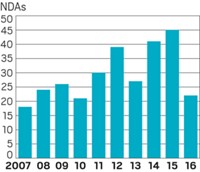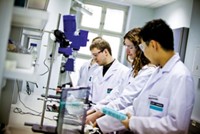Advertisement
Grab your lab coat. Let's get started
Welcome!
Welcome!
Create an account below to get 6 C&EN articles per month, receive newsletters and more - all free.
It seems this is your first time logging in online. Please enter the following information to continue.
As an ACS member you automatically get access to this site. All we need is few more details to create your reading experience.
Not you? Sign in with a different account.
Not you? Sign in with a different account.
ERROR 1
ERROR 1
ERROR 2
ERROR 2
ERROR 2
ERROR 2
ERROR 2
Password and Confirm password must match.
If you have an ACS member number, please enter it here so we can link this account to your membership. (optional)
ERROR 2
ACS values your privacy. By submitting your information, you are gaining access to C&EN and subscribing to our weekly newsletter. We use the information you provide to make your reading experience better, and we will never sell your data to third party members.
Policy
C&EN At Pittcon
by Rudy Baum
March 10, 2008
| A version of this story appeared in
Volume 86, Issue 10
C &EN had a sizable presence at Pittcon 2008, held last week in New Orleans. That should not be surprising since laboratory instrumentation forms such a key component of C&EN's editorial coverage and advertising base.
Editorially, in addition to myself, four C&EN reporters covered various aspects of Pittcon. Led by Senior Correspondent Stu Borman, Senior Editors Celia Arnaud, Mitch Jacoby, and Steve Ritter spread out to attend Pittcon's numerous press conferences and technical sessions and visit companies in their booths on the vast floor of New Orleans' Ernest N. Morial Convention Center. Their reports, including a special extended edition of C&EN's Inside Instrumentation providing descriptions of many of the new products introduced this year at Pittcon, will appear in the March 24 issue.
On the advertising front, C&EN's entire U.S. advertising sales team, led by Ben Jones and Ken Carroll, attended Pittcon. As I have pointed out on this page occasionally, advertising revenue is an essential component in C&EN's overall budget, and instrumentation advertising is a significant contributor to that revenue. The efforts of Jones, Carroll, Dean Baldwin, Lisa Kerr, Bob LaPointe, and Tom Scanlan at Pittcon and throughout the year make it possible for ACS to deliver C&EN to you each week.
In addition to attending a number of press conferences and social events, I, too, was busy in New Orleans. On Sunday morning before the conference officially opened, C&EN hosted its annual Pittcon employment workshop. I moderated the workshop, where more than 100 job seekers came to hear three presentations on the employment climate. C&EN Senior Editor Corinne Marasco, who anchors the magazine's employment beat, provided a comprehensive overview of the employment landscape for chemists. Anne Eickhoff, supervisor for quality control at GSK Biologicals in Hamilton, Mont., and Randy Hughes, director of human resources at AMRI in Albany, N.Y., gave very informative presentations about the hiring climate at their companies and what job seekers need to know about selling themselves to prospective employers.
I also moderated the annual C&EN breakfast at Pittcon, held on the Tuesday morning of the meeting now for almost three decades. This year, we were fortunate to have two speakers who are unrivaled in their knowledge of the pharmaceutical R&D environment: John L. LaMattina, recently retired president of Pfizer Global Research & Development, and Magid Abou-Gharbia, senior vice president and head of chemical and screening sciences at Wyeth.
Both LaMattina and Abou-Gharbia addressed pressing issues facing the pharmaceutical industry in their talks. LaMattina focused on the perceived decline in the productivity of the pharmaceutical industry. Newspaper headlines, he noted, paint a gloomy picture of declining New Drug Applications (NDAs) over the past decade. However, he noted, the graphs that appear with these stories almost always seem to start with 1996, which, he explained, saw an unusually high number of NDAs.
LaMattina reviewed three factors that are cutting into NDAs: industry consolidation, an increase in required safety data, and an increase in data to differentiate new drugs from existing ones. Nevertheless, he said, "despite the shift in the drug approval landscape, one should be optimistic about the future of pharma R&D. Industry has adapted to the new environment in the past five years."
Abou-Gharbia addressed the pharmaceutical industry's public image, which he said was "bad and getting worse." He pointed to numerous issues confronting the industry, including high prices, the needy's lack of access to drugs, and the perception that pharma doesn't discover new drugs, just markets them. He addressed each issue in his talk, observing that often the common wisdom just isn't true. He pointed out, for example, that more than 93% of the drugs on the market were discovered by pharmaceutical companies. Pharma, he said, spends more on R&D than any other industry.
"The pharmaceutical industry is committed to innovation," Abou-Gharbia concluded. "The days of me-too drugs are over."
Thanks for reading.
Views expressed on this page are those of the author and not necessarily those of ACS.




Join the conversation
Contact the reporter
Submit a Letter to the Editor for publication
Engage with us on Twitter